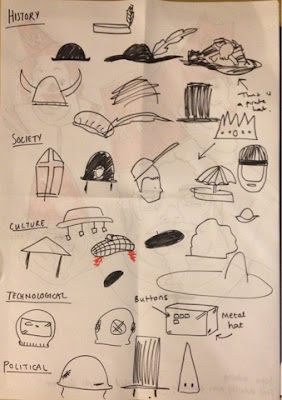Research Question needs to be focussed and specific
Practical work needs to be general and broadWhen starting to think about the practical work, it should be:
Explorative
Speculative
Relative
Open
Playful
We spent the session drawing in order to begin conjuring up ideas and ways in which we can begin thinking more about our sketchbooks. The first task was to quickly draw ten things to do with the words political and NHS together.
Then we had to take one of these drawings and come up with another ten to do with a social issue reflecting on that.
Following this, we took one drawing from the first ten, one from the second, and combined them along with something to do with our theme in a way that it would link in with our essay.
Whaaaaaat...
I did some really terrible drawings of some equally terrible ideas that are barely worth blogging:
I found this really tricky for a bunch of reasons:
1. It's hard to come up with ten different ideas in such a short amount of time
2. Drawing with no reference at all means ideas don't always come out right
3. Drawing about something I know little about is a challenge
4. Trying not to go for the obvious is hard
5. Combining the ideas of images without just creating a bizarre hybrid image that makes no sense is difficult
6. It was friday afternoon and my brain was not functioning
This task introduced us to the idea of instinctive drawing in order to think through the process.
- Trying to conceptualise
- It wasn't to do with the quality (thank god) but the ideas
The last task asked us to draw a bunch of hats reflecting the themes: Historical, social, cultural, technological and political
Then we had to draw a hat relating to our theme
I definitely think the session helped. It clarified that the drawing side of the module can be really loose, general and it can go off on tangents (to some extent) as long as its about getting ideas down
Research Question Feedback with Pete
I also had a chat with Pete at the end to narrow down on my research question and I'm now going more down the path of researching the representation of the family unit in fast food advertising.
I was told to look at advertising from the 50s up until now, and look at the similarities of the nuclear family
I can look at the adverts of McDonalds and KFC who have continuously focussed on social issues, relationships, emotions etc for their ad campaigns. Using new issues for branding. Adoption, step parents. Now focussing in on the 'less typical' family in order to relate to more people.
- Look at Naomi Klein - No Logo
One chapter in particular - The Brand Expands
I need to come up now with a specific question.







































